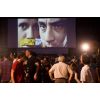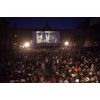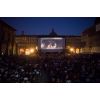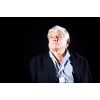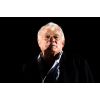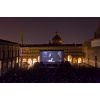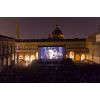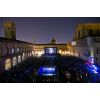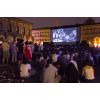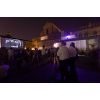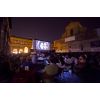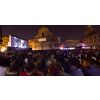
C’ERA UNA VOLTA IN AMERICA
(Once Upon in America, USA/1984) di Sergio Leone (245')
Introducono Claudio Mancini, Raffaella Leone ed Enrico Medioli
Serata promossa da Gucci
Restaurato da Fondazione Cineteca di Bologna in collaborazione con Andrea Leone Films e Regency Enterprises, grazie al contributo di Gucci e The Film Foundation
Tra la preparazione di C'era un volta il West (1968) e quella di Giù la testa (1971), Sergio Leone si appassionò a un romanzo di quattrocento pagine sui gangster ebrei, The Hoods (in Italia, Mano armata). Harry Gray, pseudonimo dell'autore, lui stesso unex gangster, lo aveva scritto mentre scontava la sua pena a Sing Sing. Leone lo incontrò a fine anni Sessanta e rimase affascinato da questo ex malvivente, che rispondeva a monosillabi ("Sì, no, forse" fu tutto quello che riuscì strappargli), che non aveva nulla della gloria dei banditi raccontati da Hollywood e che condivideva con lui il medesimo immaginario, formatosi nelle sale cinematografiche. Leone capì che The Hoods gli avrebbe consentito di lavorare non più su personaggi mitici ma sul Mito stesso: sulla sua trasmissione, sui generi cinematografici e sulle loro filiazioni, sull'infanzia del Novecento, in una specie di Ricerca del tempo perduto collettiva. La costruzione di questa cattedrale (così Enrico Medioli chiamò il lavoro preparatorio) sarebbe durata a lungo. Tra Giù la testa e Once Upon a Time in America passarono undici anni. In un'intervista, scherzando sull'enorme tempo impiegato per realizzare il film, Leone avrebbe citato Joseph Conrad: "Credevo fosse un'avventura. Invece era la vita". Secondo i suoi collaboratori, tra il 1967 e il 1977 Leone non lavorò su un copione, ma solo su infinite versioni orali. I diritti cinematografici del romanzo non erano disponibili e dopo molti e inutili tentativi sarà Alberto Grimaldi, già produttore di Leone, ma anche di Fellini, Pasolini, Bertolucci, a riuscire a ottenerli e a chiedere a Norman Mailer di scrivere una prima sceneggiatura. Leone però non trovò interessante quella prima stesura, e per scrivere si circondò di uno straordinario gruppo di sceneggiatori italiani: Kim Arcalli (geniale collaboratore di Bertolucci), Enrico Medioli (autore di sette sceneggiature per Visconti), Leo Benvenuti e Piero De Bernardi (che con Amici miei erano stati capaci di raccontare il tema dell'amicizia in maniera totalmente nuova). Al gruppo si aggiunse in un secondo momento un giovane critico, Franco Ferrini (e molto più tardi, nella fase finale di stesura dei dialoghi inglesi, Stuart Kaminsky). Medioli dirà: "Nessuno di noi sceneggiatori è americano, nessuno di noi è ebreo, nessuno di noi è gangster, tutto è filtrato attraverso il cinema, più che attraverso la letteratura". Al centro del racconto ci sono brandelli della memoria di Noodles, velati dall'oppio, intrisi di nostalgia, sfuggenti a ogni ordine cronologico, perché Once Upon a Time in America non è un biopic: è il fluire della vita di un uomo che per trent'anni non ha fatto che pensare e ripensare alla propria esistenza, maniacalmente ripercorrendo frasi, gesti, suoni del passato. Il risultato del lungo lavoro di scrittura produce una sceneggiatura di circa cinque ore, troppo per Grimaldi, reduce dalla difficile esperienza di Novecento (che era uscito in due parti). Nel 1980 Leone incontra Arnon Milchan e la Warner e il film sembra finalmente arrivare alla svolta finale, anche perché Robert De Niro accetta di essere Noodles. De Niro offre a Leone la possibilità "di fare Pinocchio con un bambino vero", liberandolo dal ruolo di burattinaio e consentendogli di divenire il narratore. La coppia James Woods e Robert De Niro ha aggiunto alla sceneggiatura una forza realista e autentica che il cinema di Leone non aveva ancora conosciuto. Se è Leone il cantore di questo inno al cinema, occorre ricordare che se non avesse avuto al suo fianco alcuni dei massimi artisti del cinema italiano non avrebbe potuto creare un brillante così prezioso, ricco di sfaccettature e luminoso. La colonna sonora di Ennio Morricone, in simbiosi perfetta con le immagini come nei precedenti film di Leone, per la prima volta usa alcuni brani famosi del Novecento (oltre alla Gazza ladra di Rossini) e diventa parte integrante della narrazione: sorregge gli incastri della struttura narrativa e permette di collocare temporalmente i ricordi di Noodles. Morricone l'aveva preparata già a metà anni Settanta e fu utilizzata (come si usava nel muto) durante le riprese, per ispirare la recitazione degli attori. Nove mesi di riprese a Parigi, sul lago di Como, a New York, Roma, Miami, Venezia, nel New Jersey, a Montreal. Once Upon a Time in America è uno degli ultimi colossal realizzati prima del digitale. Tutto quello che vediamo è realmente esistito davanti alla macchina da presa. Lo scenografo Carlo Simi, la costumista Gabriella Pescucci, il direttore della fotografia Tonino Delli Colli hanno compiuto il miracolo di restituire il clima visivo di tre epoche, lavorando tra Nord America ed Europa con minuziosa cura del dettaglio, con scrupolosa veridicità. A montaggio avanzato esplode il problema della durata: la prima versione dura quattro ore e venti minuti, Milchan e la Warner si aspettavano un film di non oltre 160 minuti. Ma Leone aveva in mente il suo film. Alla fine della lotta la versione americana, con le scene rimontate in senso cronologico, dura 1 ora e 34 minuti e non viene firmata da Leone; la versione europea, presentata a Cannes nel maggio del 1984, dura 3 ore e 49 minuti. Dalla versione europea vennero allora eliminate diverse sequenze che oggi, grazie alla testarda volontà della famiglia Leone, alla perseveranza della Film Foundation, al sostegno di Gucci, e all'avente diritto New Regency, abbiamo potuto ritrovare e reinserire in questa 'ricostruzione' di Once Upon a Time in America. Tra queste sequenze, molti passaggi che spesso Leone ricordava, con il rammarico di avervi dovuto rinunciare: come l'apparizione di Louise Fletcher, premio Oscar per Qualcuno volò sul nido del cuculo, che interpretava la parte della direttrice del cimitero ed era scomparsa dal film, e la scena dove Deborah (Elizabeth McGovern) recita a teatro il ruolo di Cleopatra. La versione ricostruita dura ora 4 ore e 15 minuti. In Once Upon a Time in America ci sono tutti gli elementi che caratterizzano il cinema di Sergio Leone: epica, morte, amicizia, ricordi, rapine, tradimenti, un duello lungamente annunciato, una presenza 'visiva' della colonna sonora, l'uso stupefacente del dolly e dei movimenti di macchina. Eppure il film è molto diverso dai suoi precedenti: thriller, melodramma, citazioni dei classici del cinema gangsteristico, ma anche di Chaplin, di Welles e del neorealismo, convivono in un viaggio verso l'oblio e la morte nel quale lentamente scopriamo la disperazione di Noodles, all'interno di una grandeur cinematografica e irreale. In questa storia circolare, in cui tutto viene sempre rinviato e tutto resta immutabile, in un'America che non è più il paese dove si avverano i sogni, ma un luogo oscuro dove una parabola di potere può finire in un tritarifiuti, Noodles è un antieroe che ha l'aura del personaggio epico, un esiliato che non può più ritornare a casa, perché non c'è più casa che non sia solo un ricordo drogato. Leone mette in scena ancora una volta i miti umani, ma qui anche il miracolo e il mistero della loro esistenza, osserva gli accadimenti in una prospettiva cosmica, scruta i suoi personaggi con pietà e commozione. Il memorabile sorriso estatico di De Niro, nel finale, è un tradimento liberatorio delle convenzioni del cinema, ma è anche la logica conclusione di un film che per Leone era "una sorta di balletto di morte della nascita di una nazione... [dove] tutti i miei personaggi guardano in faccia la morte". Sarà l'ultima inquadratura del suo cinema. Sergio Leone morirà nel 1989, mentre, a casa sua, vedeva il film di Robert Wise Non voglio morire.
(Gian Luca Farinelli)
In between shooting Once Upon a Time in the West (1968) and Duck, You Sucker! (1971) Leone fell in love with a four hundred page novel about Jewish gangsters, The Hoods. Harry Grey, the author's pseudonym, himself an ex-gangster, wrote it while doing time in Sing Sing. Leone met him at the end of the Sixties and was intrigued by this ex-hoodlum who responded with monosyllabic answers - "Yes, no, maybe" was all he was able to drag out of him - and represented none of the glory of criminality as depicted by Hollywood, who also shared with him the same imagination, formed in cinema theatres. Leone understood that The Hoods would give him the opportunity to work, not on mythical characters as in his previous work, but on the Myth itself, on its transmission, on film genres and their derivations, on the infancy of the 20th century in a collective Recherche du Temps Perdu. The construction of this cathedral (as Enrico Medioli called the preparatory work) took a long time. 11 years passed between the making of Once Upon a Time in America and his previous film, Duck, You Sucker! In an interview, Leone paraphrased Joseph Conrad when joking about the enormous amount of time it took to make the film: "I believed it was an adventure. Instead, it was life". According to those who collaborated with him between '67 and '77, Leone didn't work on a script, instead the story evolved through infinite oral versions. The cinematographic rights to the novel weren't initially available and after many fruitless attempts it would eventually be Alberto Grimaldi, the producer of some of Leone's earlier work, as well as films by Fellini, Pasolini and Bertolucci, who managed to free up the rights and ask Norman Mailer to write a screenplay. Leone didn't find that first draft interesting and for the rewrite he gathered an extraordinary group of Italian screenwriters around him: Kim Arcalli (Bertolucci's brilliant collaborator), Enrico Medioli (writer of seven screenplays for Visconti), Leo Benvenuti and Piero De Bernardi (who, in Mario Monicelli's film My Friends, reinterpreted the theme of friendship in a entirely new way). Later on, a young critic named Franco Ferrini joined the group (and, much later, during the final drafting of English language dialogue, Stuart Kaminsky). Medioli said: "None of us screenwriters are American, none of us are Jewish, none of us are gangsters. Everything is filtered through the cinema, rather than through literature". At the centre of the story are Noodles' memories, shredded by the effects of opium, saturated with nostalgia, impossible to retell in chronological order, but Once Upon a Time in America isn't a biopic, it is the memory of a man's life who, for over thirty years, has been examining and re-examining, over and over, his whole existence, specific details and events, obsessively retracing words, gestures, echoes from his past. The result of this lengthy writing process was a screenplay of almost five hours in length, proving too much for Grimaldi, defeated by his experiences with Bernardo Bertolucci's 1900, which had been released in two parts. In 1980, Leone met with Arnon Milchan and Warner Brothers and finally it appeared as though the film was on the verge of being made, also because Robert De Niro had accepted to play Noodles. De Niro offered him the possibility of letting "Pinocchio become a real boy", thereby freeing him from the role of puppeteer and allowing him to become the narrator. The pairing of James Woods and Robert De Niro added an authentic and realistic force to the screenplay, which Leone's cinema had not previously known. Leone is the singer of this anthem to the cinema. However - and it goes without saying - if he hadn't had some of the greatest artists from the golden age of Italian cinema by his side, he would never have been able to create a gem so precious, so richly faceted, so luminous. As in his previous films, Morricone's soundtrack is in perfect symbiosis with the images, but here, for the first time, it contains some famous songs from the 20th century (as well as Rossini's Gazza ladra) and is an integral part of the narration: it supports the jigsaw puzzle narrative structure, thus allowing us to temporally locate Noodles' memories. Morricone © Schizzo di Renato Casaro per Once Upon a Time in America. Collezione Maurizio Baroni already had the soundtrack prepared in the mid-Seventies and during the shoot it was used to inspire the actors, as they did in the silent era. The film was shot over nine months in Paris, Lake Como, New York, Rome, Miami, Venice, New Jersey and Montreal. It was one of the last epics to be shot before the advent of the digital age. Everything we see actually existed in front of the camera. Art director Carlo Simi, costume designer Gabriella Pescucci and cinematographer Tonino Delli Colli achieved a miracle of storytelling, recounting three eras with meticulous attention to detail, precision and scrupulous veracity while working between North America and Europe. During the advanced editing stages the issue of duration arose: the first version had a running time of four hours and twenty minutes. Milchan and Warner Brothers expected a film of no more than 160 minutes, but Leone had his film in mind. At the end of the struggle the American version, with the scenes reedited in chronological order and not approved by Leone, lasted 1 hour and 34 minutes, while the European version, presented at Cannes in May 1984, lasted 3 hours and 49 minutes. Several sequences had been eliminated, which, thanks to the stubborn will of the Leone family, the perseverance of The Film Foundation supported by Gucci and the rights owner New Regency, we have been able to find and re-insert where Leone had originally intended them. Beginning and end frames of the cut scenes allowed us to identify the exact place they were deleted from. Leone often recalled many of these scenes with regret, such as the appearance of Louise Fletcher, Oscar winner for One Flew Over the Cuckoo's Nest, as the director of a cemetery, which disappeared from the film along with the scene of Deborah (Elizabeth McGovern) reciting as Cleopatra. This newly reconstructed version lasts 4 hours and 15 minutes. All the characteristic elements of Sergio Leone's cinema are to be found in Once Upon a Time in America: myth, death, friendship, memories, robberies, betrayals, a much anticipated duel, the 'visual' presence of the soundtrack, the amazing use of dolly shots and camera movement. However, the film is very different from his previous work: thriller, melodrama, citations from gangster cinema classics, as well as the cinema of Chaplin, Welles and Neo-realism all come together in a voyage towards oblivion and death, in which we slowly discover, within this unreal cinematographic grandeur, Noodles' desperation and anguish. In this circular story, where everything is always postponed and remains inalterable, in an America which is no longer the country where dreams come true, but where power can only ever end up ground to nothing, Noodles is an antihero with the aura of an epic character, an exile that can no longer return home, because home only exists in his memories. Observing happenings from a cosmic perspective, examining his characters with compassion and emotion, once again Leone depicts human myths, but here we also find the miracle and mystery of their existence. De Niro's memorable ecstatic smile in the film's finale is a liberating betrayal of cinematic conventions, but it is also a logical conclusion to a film which Leone considered to be "A sort of death dance at the birth of a nation... [where] all my characters stare death in the face". It was to be the last frame of his cinema. Leone died in 1989, while at home watching Robert Wise's film I Want to Live!
(Gian Luca Farinelli)

Tariffe:
Ingresso libero


